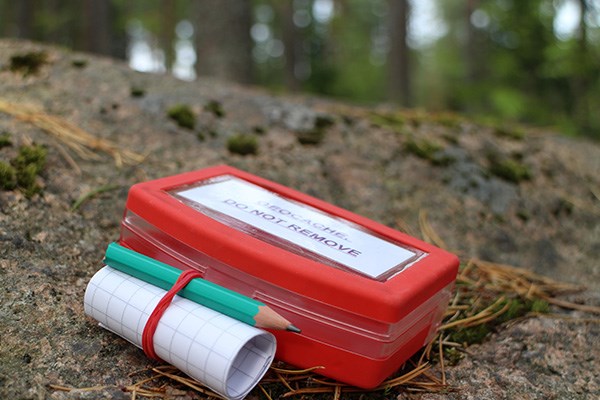The other day my youngest, now seven, came home from a walk in the forest with a sack full of loot. It wasn’t her normal collection of sticks, moss and fallen bird’s nests. Instead she had a resealable plastic bag with what looked like a time capsule someone didn’t bury well enough.
Inside, there was a random sampling of small children’s toys, utilitarian items I imagine might be useful for trading post-apocalypse, a pencil and something labelled a geocache coin.
Unfortunately, it was completely soaked inside and out. Whoever tucked it into its location obviously didn’t secure it well enough to weather this month’s intense rains; the wee enclosed notebook could have been wrung out like a sponge.
So what was this varied assortment of stuff? Turns out it was a geocache – and for the record should not have been removed, but Little Sister didn’t know that. And geocaching is a thing.
According to the REI website, the short, humorous definitions of geocaching is this: “Using billions of dollars of military hardware to find Tupperware hidden in the woods.” The more helpful answer: geocaching uses handheld GPS units to find hidden caches in your neighbourhood or out on the trails. Caches are containers of all sizes that may be camouflaged to blend into their surroundings. Inside there will be – at a minimum – a logbook to sign. Larger caches will also contain various inexpensive trinkets for trade.
So that explained the toy that looked like it came from a kid’s meal. And the soaked scribbler.
Upon closer inspection, the notebook was half-filled with inscriptions that ranged from the kind we used to collect in our autograph books as school-aged children to simply names and countries of those who had unearthed the cache from inside the stump of a tree.
We knew at this point that we had to return the cache, though some preservation and upkeep was required: We cleaned off and dried out what we could. We replaced the notebook, which was sadly unsalvageable, and put in a new pencil and a couple of things from around the house. And at the same time, my daughters put together an entirely new cache and chose a different location to stash their stuff. Dad fortunately has access to GPS technology so that part was a snap, though I suspect most smart phones can do the job.
After accessing a proper geocache app and looking at a few websites, most of the family (not me) has become familiar with proper geocache etiquette and also many other locations throughout Squamish where we can search out and even re-visit these treasure troves time and again. I understand there are quite a few up on the Chief, and I imagine the trail up the gondola won’t soon be far behind.
We’ve never had a problem getting our kids out to explore in the forest, but for those of you who struggle, geocaching is a great way to get them excited about being in nature, helping to locate sources of new-found booty and a plethora of other adventures as well. Case in point: The last outing my youngest went on with her father, they discovered a “secret ninja training camp” in the middle of nowhere, as well as unearthing and studying a Northern salamander – which, when we looked it up on the Internet, we discovered had a poisonous tail.
There were a multitude of experiences all wrapped up in one. And a two-hour-long outing stretched into an entire afternoon of research and discovery both in the woods and later at home, with plans to find many more around town.
And all because of an accidental discovery.



